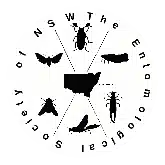Contents Vol. 45
GENERAL AND APPLIED ENTOMOLOGY
The Journal of the Entomological Society of New South Wales Inc.
VOLUME 45
CONTENTS
DOMINAK, B. C. and WORSLEY, P. Review of the southern boundary of Jarvis fruit fly Bactrocera jarvisi (Tyron) (Diptera: Tephritidae: Dacinae) and its likely southern distribution in Australia. ………………… 1
bernie.dominiak@dpi.nsw.gov.au
Some international trading partners are interested in the distribution of the lesser known Australian fruit flies. Historical and current records for Bactrocera jarvisi were reviewed. Despite historical reports claiming B. jarvisi as far south as Sydney, current records indicated that there were only two years in 15 when B. jarvisi was detected in low numbers in the New South Wales fruit fly surveillance grid. It is likely that these detection were from incursions that did not establish, rather than from local populations. Current records support the concept that B. jarvisi is closely linked to its native host, cocky apple, which is known to be distributed in northern Western Australia, Northern Territory and the Queensland coast down to Maryborough. All states and territories other than Queensland, Northern Territory and Western Australia should be considered free from B. jarvisi.
General & Applied Entomology 45: 1–7.
HALES, D. F., GILLESPIE, P. S, WADE, S. and DOMINIAK, B. C. First detection of Megoura crassicauda Mordvilko (Hemiptera: Aphididae) in Australia and a review of its biology .…………… 77
Aphids are important pests of crop production. Australia has been subject to many aphid incursions. In this paper, we describe the first detection in Australia of the bean or vetch aphid Megoura crassicauda Mordvilko, a pest of broad beans (Vicia faba L.) and related legumes, and provide background information on the insect. The potential to establish and spread is discussed.
General & Applied Entomology 45: 77–81.
SMITH, G. The Australian silverfish fauna (Order:Zygentoma) abundant, diverse, ancient and largely ignored.……………………. 9
le_gbsmith@optusnet.com.au
The Australian silverfish fauna is reviewed at the level of genus, based on the literature and almost 1000 additional collection events. The morphology, biology and collection methods for the Zygentoma are briefly reviewed. A key to the genera found in Australia is provided. Seventy species in 23 genera in two of the five extant families have now been described. Of these, six species are introduced cosmopolitan anthropophilic species, although only one of these (Ctenolepisma longicaudata Escherich) is common and of only limited economic importance. The fauna demonstrates a high degree of endemism with 88% of described species and 52% of genera known only from Australia . Four (of six) subfamilies of the Lepismatidae are represented by autochthonous species. The lepismatid genera Acrotelsella Silvestri and Heterolepisma Escherich are very abundant but only a very small percentage of their species have been described; both genera have ranges extending beyond Australia. Within the Nicoletiidae, three of the five subfamilies are represented, many collected from deep subterranean habitats via mining exploration bore holes and many still undescribed. Eight genera of the inquiline Atelurinae belong to a single tribe, the Atopatelurini, with Wooroonatelura Smith currently unplaced. Four of these supposedly inquiline genera have been collected from caves or deep subterranean habitats with no obvious host association. The zoogeography of this ancient Order and conservation issues are discussed.
General & Applied Entomology 45: 9–58.
WOOLLEY, L.K., YIZHOU CHEN, LANGFIELD, K. L. and HERRON, G. A. High quality DNA extraction from Helicoverpa armigera for next generation sequencing. ……………………… 59
yizhou.chen@dpi.nsw.gov.au
Modern sequencing technologies such as massively parallel sequencing with high throughput require input of high quality DNA. Numerous methods exist for the isolation of high quality DNA from insects, including commercially available kits such as the DNeasy Blood and Tissue kit (Qiagen) and the Isolate II Genomic DNA kit (Bioline). Here we isolated DNA from Helicoverpa armigera (cotton bollworm or old world bollworm) using the DNeasy method and the Isolate II Genomic DNA kit, and assessed the use of pure, high molecular weight extracts for genotyping by sequencing. High quality DNA suitable for genotyping by sequencing was only achieved using the DNeasy Blood and Tissue kit. Furthermore, selective tissue sampling from the head only proved vital in obtaining high quality DNA, with extracts from the thorax and abdomen often degraded or containing low molecular weight contaminants.
General & Applied Entomology 45: 59–64.
DOMINIAK, B. C. and FANSON, B. G. Assesing the proportion of nutrients removed from the larval diet by Queensland fruit fly (Bactrocera tryoni) at a mass rearing facility and possible uses of spent media. ………. 71
bernie.dominiak@dpi.nsw.gov.au
Queensland fruit fly (Qfly) is a major horticultural pest in Australia. The Sterile Insect Technique (SIT) has been used to manage Qfly incursions for over two decades. As part of the SIT programme, millions of sterile Qfly are produced at a mass-rearing facility in Camden, NSW, resulting in the disposal of tonnes of spent larval diet each year. We analysed the nutritional composition of spent larval media to identify possible uses as a livestock feed. Nutrients remaining in spent media were compared with fresh, unused media. The largest change in diet quality was in water soluble carbohydrates, which decreased significantly from 35% to 15%. Crude protein significantly increased from 17.6% to 18.2% and crude fat increased significantly from 1.0% to 1.3% possibly due to the presence of residual Qfly larvae in spent media. There was a significant decrease in dry matter, organic matter and digestibility of organic matter. Given its nutritional composition, spent fruit fly media has the potential to be used as a livestock feed, thereby reducing the current economic and environmental costs of spent media disposal.
General & Applied Entomology 45: 71–75.
BOOK REVIEW
A Guide to Stag Beetles of Australia …………………………………… 65
The Secret Life of Flies ………………………………………………… 67
A Field Guide to the Spiders of Australia ……………………………… 69
